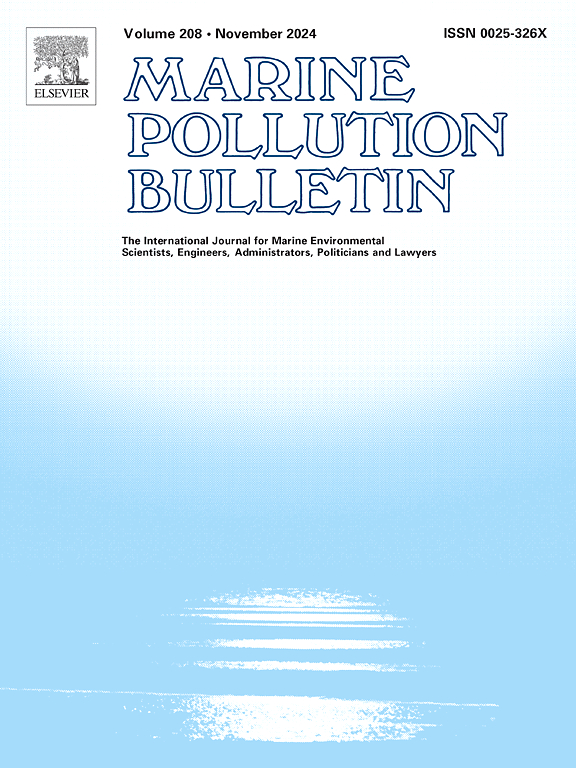Highway runoff and recreational activities as primary sources of microplastics in the watershed of the SW Atlantic Mar Chiquita coastal lagoon (MAB-UNESCO)
IF 4.9
3区 环境科学与生态学
Q1 ENVIRONMENTAL SCIENCES
引用次数: 0
Abstract
Plastic waste pollution is one of the most significant global challenges today, and it is urgent to reduce, mitigate, and assess its levels in various environmental matrices and priority areas. Coastal aquatic environments act as sink areas, where the watershed collector effect could lead to microplastic deposition. The Mar Chiquita coastal lagoon (Mch, Buenos Aires, Argentina) lies within a protected area receiving water from a 10,000 km² watershed with diverse land uses. This study aims to determine the occurrence and abundance of microplastics (0.1-5 mm) in surface sediments from 18 sampling sites, including the upper, middle, and lower basin areas, as well as sites within the coastal lagoon. Microplastics were extracted using a high-density solution (>1.6 g/cm3), counted, and categorized by type, shape, size, and chemical composition. Results showed total microplastic abundances ranging from 0 to 2468 items per kilogram of dry weight. The higher abundance trends were associated with areas of high traffic and human settlement, specifically in streams and the coastal lagoon, respectively. Common thermo/duroplastics particles (MPs; 5-100%) and tire wear particles (TWPs; 0-95%) represented the main microplastic groups observed in the Mch basin, while Paint particles (Pps) contribution was lower (0-15%). MPs were predominantly composed of polyethylene terephthalate (32%) and polyethylene (24%), while TWPs mainly consisted of polyisoprene and polybutadiene, and PPs were primarily associated with epoxy resins or acrylic paints. This work represents the first baseline assessment of microplastic pollution in the sediments of this priority conservation area on the southwestern Atlantic coast.

公路径流和娱乐活动是西南大西洋奇基塔海岸泻湖流域微塑料的主要来源(MAB-UNESCO)
塑料废物污染是当今最重大的全球挑战之一,迫切需要减少、缓解和评估其在各种环境矩阵和优先领域的水平。沿海水生环境作为汇区,集水区效应可能导致微塑料沉积。Mar Chiquita海岸泻湖(阿根廷布宜诺斯艾利斯)位于一个保护区内,从10000平方公里的不同土地用途的流域取水。本研究旨在确定18个采样点的表层沉积物中微塑料(0.1-5毫米)的发生率和丰度,包括上、中、下盆地地区,以及沿海泻湖内的地点。使用高密度溶液(>1.6 g/cm3)提取微塑料,按类型、形状、大小和化学成分进行计数和分类。结果显示,每公斤干重的总微塑料丰度从0到2468个。高丰度趋势与高交通量和人类住区有关,特别是在河流和沿海泻湖。普通热塑性/硬质塑料颗粒(MPs;5-100%)和轮胎磨损颗粒(TWPs;0-95%)是Mch盆地中观察到的主要微塑料群,而油漆颗粒(Pps)的贡献较低(0-15%)。MPs主要由聚对苯二甲酸乙二醇酯(32%)和聚乙烯(24%)组成,twp主要由聚异戊二烯和聚丁二烯组成,PPs主要由环氧树脂或丙烯酸涂料组成。这项工作代表了西南大西洋海岸这个优先保护区沉积物中微塑料污染的第一个基线评估。
本文章由计算机程序翻译,如有差异,请以英文原文为准。
求助全文
约1分钟内获得全文
求助全文
来源期刊

Marine pollution bulletin
环境科学-海洋与淡水生物学
CiteScore
10.20
自引率
15.50%
发文量
1077
审稿时长
68 days
期刊介绍:
Marine Pollution Bulletin is concerned with the rational use of maritime and marine resources in estuaries, the seas and oceans, as well as with documenting marine pollution and introducing new forms of measurement and analysis. A wide range of topics are discussed as news, comment, reviews and research reports, not only on effluent disposal and pollution control, but also on the management, economic aspects and protection of the marine environment in general.
 求助内容:
求助内容: 应助结果提醒方式:
应助结果提醒方式:


